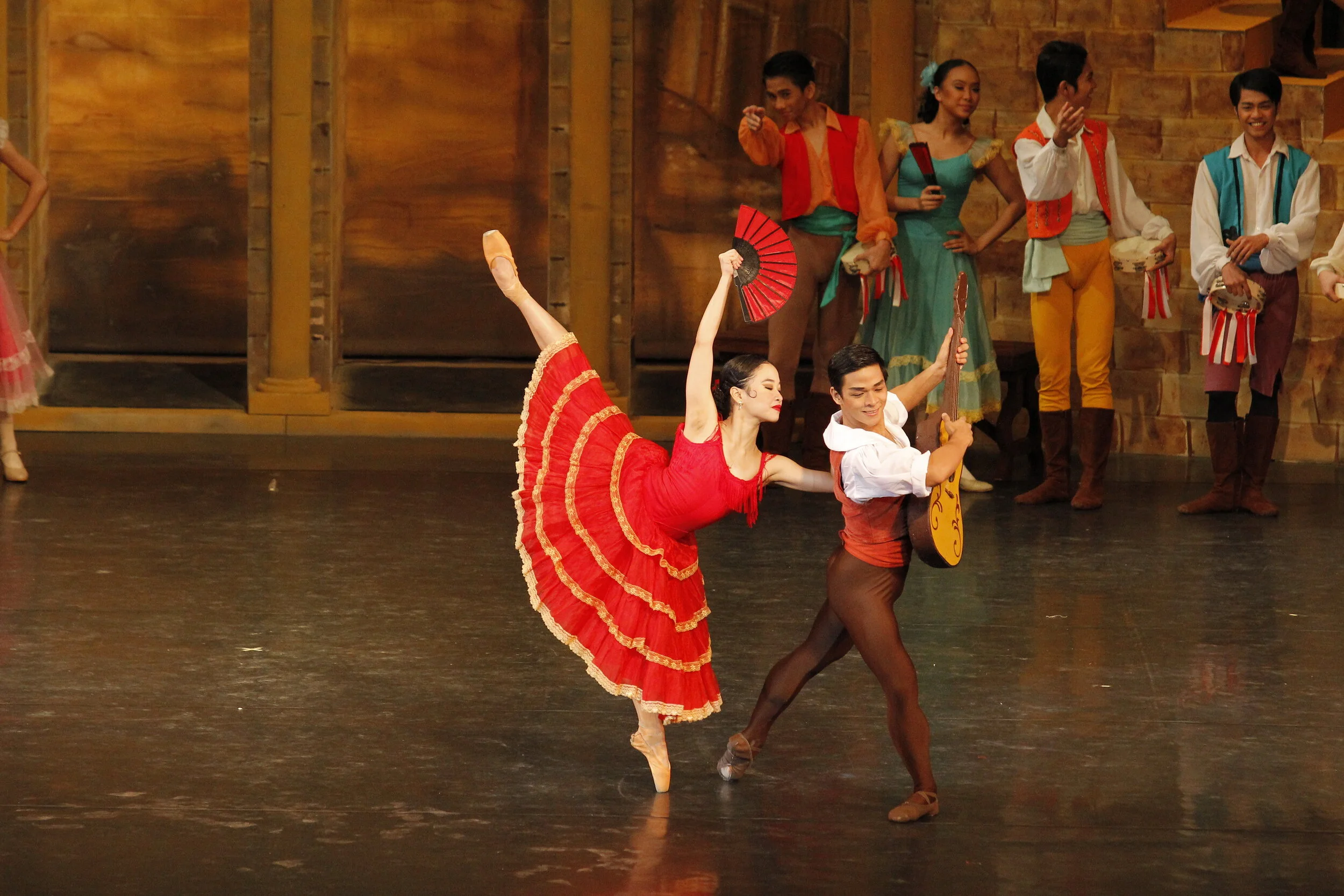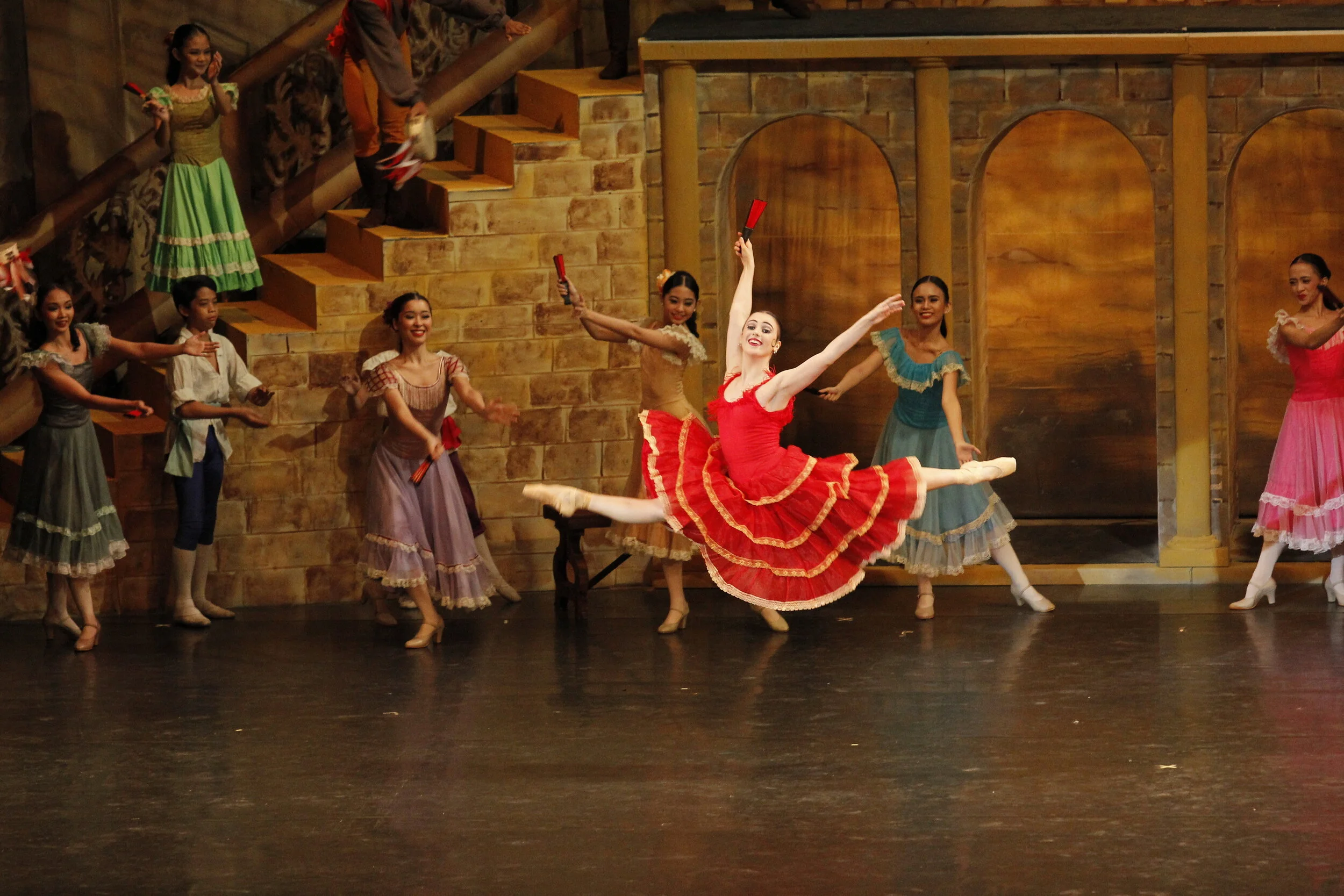Don Quixote: The feisty and playful Kitri
Kirov Ballet prima ballerina Gabriela Komleva teaches a young Lisa Macuja the intricacies of being Kitri for her debut in Don Quixote with the famed Russian company in 1986.
Fiery, feisty, fierce and playful – these are the oft-repeated adjectives used when describing Kitri, the innkeeper’s daughter who is at the center of the plot of Don Quixote, the ballet. As the story goes, the young lass falls in love with the town barber, Basilio, though her father prefers the wealthy Gamache.
But Kitri is no shy violet. The moment she steps on the stage, she commands attention effortlessly. A woman ahead of her time, it was clear from the beginning that she would not sit idly and let her father decide her future. And that future, she has decided, includes Basilio rather than Gamache.
Jasmine Pia Dames and Gerardo Francisco are well-matched as the playful couple in Don Quixote, Kitri and Basilio, in 2017. Photo by Ocs Alvarez
Since she first debuted in 1740 in Vienna, Austria, Kitri has become the most coveted role, particularly among young ballerinas eager to showcase their strength and technique. The version of Don Quixote choreographed by the legendary Marius Petipa for the Bolshoi Ballet – arguably the most popular version and the source material for many other versions after – boasts of a Kitri capable of fast turns, high jumps, and effortless fun in every move. It is a role not for the faint of heart.
While younger ballerinas often get chosen, a memorable performance of Kitri requires maturity as well. The role is not just about speed and stamina. The character is distinct and must be studied in proper context for the nuances to come across clearly.
Katherine Barkman, now with The Washington Ballet, makes her debut in the full-length Don Quixote with Ballet Manila in 2017. Photo by Ocs Alvarez
Elena Kunikova, a former ballerina of the Maly Theater in St. Petersburg, told Pointe Magazine that there is often a lack of understanding on how to portray the Spanish flair. Fans and castanets are waved around recklessly. There is also the tendency to portray her as sultry as they would the Black Swan. Kitri, she stressed, should be playful, fun and joyous.
It is this joyousness that has made prima ballerina Lisa Macuja-Elizalde’s Kitri so gratifying to watch. From the time she debuted her first full-length Don Quixote in 1986 as a soloist of Kirov Ballet to her final performance in her 2012 Swan Song Series, her portrayal of what became her signature role would evolve to showcase the many techniques and pieces of wisdom she acquired as she grew as a dancer.
In 2017, five years after dancing her farewell Don Quixote, Lisa Macuja-Elizalde (foreground) coaches a new batch of Kitris in the skillful handling of the Spanish fan. With her are, from left: Jasmine Pia Dames, Dawna Reign Mangahas and Katherine Barkman. Photo by Jimmy Villanueva
“Twenty five years. Has it been that long?” wrote Macuja-Elizalde in her 2009 Director’s Notes as Don Quixote once again took centerstage in the 14th season of her own company, Ballet Manila. “I still dance Kitri today with the same castanets I performed my first one with. They were given to me by my ballet coach, People’s Artist of Russia Gabriela Komleva, a student of the late Agrippina Vaganova who perfected the ballet technique now widely known as the Vaganova method. If those castanets could talk, they would regale you with stories like when I hit my foot on a light stand just before entering for my variation in the Riga Theater in Latvia while dancing with Aivars Leimanis. Or when I was stopped from entering by the stage manager as I started to clap them together in Tblisi, Georgia because my Basilio at that time, Bolshoi Ballet’s Irek Mukhamedov, decided to do an encore to his first act variation. One of the castanets has a chipped edge which probably happened during the festival in Krasnoyarsk when I was dancing with my long-time dance partner Osias Barroso. It was his first Basilio then.”
Dawna Reign Mangahas shows her flair for the castanets in her debut full-length performance as Kitri in one of Ballet Manila’s Don Quixote shows in 2017. Photo by Ocs Alvarez
Since then, Ballet Manila has introduced many Kitris including Pamela Asprer, Aileen Gallinera, Marian Faustino, and Mylene Aggabao. But after Macuja-Elizalde bid farewell to Kitri in 2012, it took five years for the company – that has performed the classic so often in the past – to restage the full-length piece again. The reason behind the gap? The company had to wait for the right ballerinas who could give justice to the role.
The “right ballerinas” were Dawna Reign Mangahas, Katherine Barkman and Jasmine Pia Dames. For Barkman, it was a complete shift given that her previous roles were from lyrical ballets such as Giselle (Giselle) and Princess Aurora (Sleeping Beauty). For Dames, the mischievous and playful persona was in keeping with her own personality but the challenge was in building up her strength and stamina to perform the role with the same flourish from beginning to end. But it was Mangahas who gave the description that all Kitris of the world could probably relate to: “I’m not naturally quick-footed and it’s really an effort to keep up. Minsan po sa sobrang bilis ng ikot, parang naiiwan na ang kaluluwa ko!” (Sometimes I spin so fast that it feels like I’m leaving my soul behind!)
Today, only Dames remains with the company. She is also the only active female dancer who has performed the full-length Don Quixote. Fellow principal artists Joan Emery Sia and Abigail Oliveiro may yet get the chance to step into Kitri’s shoes. And the likes of soloists Nicole Barroso, Rissa May Camaclang, Shaira Comeros, and Dames’ twin, Jessica Pearl, are waiting in the wings for a chance to tackle the role when the time is right.
Nicole Barroso and Joshua Encisco perform the Don Quixote pas de deux at the International Dance Festival in Vietnam in 2017, for which she won the festival’s Best Dance Artist award. Photo by Jimmy Villanueva







